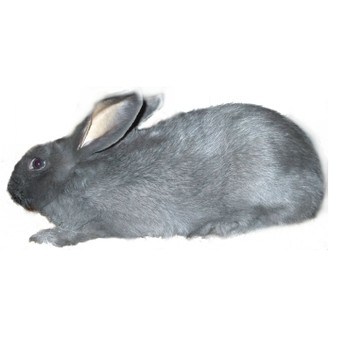Type the name of the breed you're looking for below
[wpdreams_ajaxsearchlite] Don't see the breed your're looking for? Click here and let us know!
Breed Characteristics
1 paw - breed exhibits the least amount of this characteristic
5 paws - breed exhibits most amount of this characteristic
American Rabbit
| Origin | People’s preferences change quickly, even in the rabbit world. One example of this is the American breed. Once a popular show animal, the American is now one of the rarest breeds in the United States. This large, “mandolin-type” rabbit certainly has an interesting history. It was developed in the 1910’s by a Lewis H. Salisbury of Pasadena, California. He didn’t divulge which breeds he used, but it’s generally believed that he crossed a number of blue European rabbits: the Vienna, Beveren, Blue Imperial, and Flemish Giant. Although an entirely American creation, the breed was first known as the German Blue, and held that name until World War I. The second variety, white, was added in 1925. After the Second World War, interest in the American breed declined. Commercial rabbit producers were seeking a deeper, faster-growing rabbit, while fanciers pursued the small and cute breeds, or those with interesting markings. By the 2000’s the American had become the rarest breed in this country, with fewer than 200 animals known to exist. Thankfully, help was right around the corner. In 2005, the American Livestock Breeds Conservancy (www.albc-usa.org) took rabbits under its wing. This was a big boost to heritage breeds in general. In 2006, a herd of about 40 white Americans was discovered in Alberta, Canada, owned by two ladies who had obtained the rabbits from a Hutterite community (a denomination similar to Amish). The line was traced to rabbits brought up from the US in the 1920’s, a time when Americans were prevalent. The discovery of this herd brought both fresh blood and fresh interest to the American breed. Now these distinctive rabbits are kept alive by the committed members of the “BAR” (Breeders of American Rabbits National Specialty Club.) Adult Americans weigh between 9 and 12 pounds, with does slightly heavier than bucks. They are in the semi-arch type group, meaning that the top line of the body (when viewed from the side) does not rise immediately behind the ears, but flattens over the shoulders and curves upward at the start of the midsection. The fur is a commercial flyback. Americans come in two recognized colours: blue and white. The white is ruby-eyed. The blue is a dark slate colour, in contrast to the lavender blue of the similar Beveren breed. In patriotic style, one a breeder in California has developed a red American to add to the white and blue, but is not seeking ARBA acceptance for the colour at this time. When the two recognized varieties are bred together, it allows a number of color genes to surface that the white had been hiding, and results in offspring of unrecognized colours. Fanciers are working to correct this problem by breeding out the unwanted genes and produce whites that are true “albino blues.” The goal is to produce rabbits that are genetically blue except for the albino gene, which strips the pigment from the fur and eyes. Other challenges to raising this breed include its large size and the limited availability of stock for sale. |
Physical Attributes
| Weight | 9 - 12 lbs.(4.1 - 5.4 kg.) |
| Ear Type | Erect |
| Fur Type | Commercial flyback |
| Colours | Blue and White |
| Appearance | This rabbit has well-rounded hindquarters, narrow shoulders, and long erect ears. |
| Other Considerations | Life Expectancy of 5-8 years. The American Rabbit has a docile temperament. |
| Best Kept In | Pen. Cage or Yard. |



